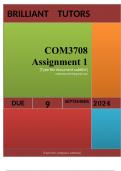BRILLIANT TUTORS
DUEDUE
COM3708
Assignment 1
[Type the document subtitle]
tabbymwesh59@gmail.com
DUE SEPTEMBER
9 2024
[Type the company address]
, Book
Advertising and Public Relations
COM3708 Assignment 1 PORTFOLIO (COMPLETE ANSWERS) Semester 2
2024 - DUE 9 September 2024 ; 100% TRUSTED Complete, trusted solutions
and explanations
PHASE 1: ASSESS Outcome of phase 1 A document should be produced
that exhaustively details particulars of the audience assessment, the
organisation's broader operations and objectives, the pertinent environmental
conditions, historical and future considerations, as well as the details,
perceptions, status and communication of the idea that forms the focus of the
campaign. The document should include a complete situation analysis.
Assessment of the relevant variables should be based on observation,
informal research and investigation and, finally, formal research. To compile
this document systematically, you should do the following: 1.1 Identify the
communicator Study section 13.5.
To compile the document systematically, it is essential to first identify the communicator.
According to study section 13.5, the communicator plays a crucial role in shaping the message
and influencing the audience. Here’s a detailed outline to guide you through the identification
process:
1.1 Identify the Communicator
Role of the Communicator:
Definition: The communicator is the individual or group responsible for conveying the
message to the target audience. This entity shapes how the message is crafted, delivered,
and perceived.
Importance: The effectiveness of communication depends significantly on the
communicator's credibility, expertise, and relationship with the audience.
Steps to Identify the Communicator:
1. Determine the Primary Communicator:
o Internal Communicators: Individuals within the organization such as managers,
team leaders, or specialized communication departments.
, o External Communicators: Outside entities such as marketing agencies, public
relations firms, or industry experts hired for the campaign.
2. Evaluate Communicator Characteristics:
o Credibility: The communicator must be trustworthy and reliable. Consider their
track record, reputation, and expertise in the subject matter.
o Authority: Assess the communicator's authority and influence within the
organization and industry. This includes their position, experience, and
recognition.
o Communication Skills: Effective communicators must possess strong verbal and
written communication skills. They should be capable of articulating the message
clearly and persuasively.
3. Define the Communicator’s Role in the Campaign:
o Message Development: Determine who will be responsible for crafting the core
message. This may involve a team of writers, strategists, and subject matter
experts.
o Message Delivery: Identify who will present the message to the audience. This
could be through various channels such as speeches, press releases, social media
posts, or advertisements.
o Engagement: The communicator should actively engage with the audience,
responding to feedback, addressing concerns, and fostering a two-way dialogue.
4. Analyze Previous Communication Efforts:
o Past Campaigns: Review previous communication campaigns to understand
what worked well and what didn’t. This provides insights into the strengths and
weaknesses of the communicators involved.
o Audience Feedback: Gather feedback from past audiences to gauge the
effectiveness of previous communicators. This can highlight areas for
improvement and success factors to replicate.
5. Align Communicator with Organizational Goals:
o Strategic Fit: Ensure the communicator aligns with the organization’s broader
operations and objectives. Their messaging should support the overall strategic
goals.
o Consistency: The communicator should maintain consistency with the
organization’s values, tone, and branding across all messages.
Documenting the Communicator:
Profile: Create a detailed profile of the identified communicator(s), including their
background, expertise, and role within the campaign.
Responsibilities: Clearly outline the specific responsibilities and expectations for the
communicator throughout the campaign.
Assessment: Provide an assessment of the communicator’s suitability based on the
criteria mentioned above.
By systematically identifying the communicator, you lay a strong foundation for the campaign's
success, ensuring the message is delivered effectively and resonates with the target audience.
, 1.2 in the prescribed book and do the following: 1.1.1 Identify an organisation
or organisations that you will approach with the proposal to plan a
communication campaign. Write down the name of the organisation(s) and its
(their) contact details.
To complete step 1.1.1, you need to identify an organization or organizations that you will
approach with the proposal to plan a communication campaign. Here's an example of how to
document this information:
1.1.1 Identify an Organisation or Organisations
Organization 1: SafeTech Solutions
Industry: Safety Management Systems
Contact Person: Mr. John Smith, Director of Safety Operations
Address: 123 Safety Avenue, Suite 456, Metropolis, 12345
Phone: +1 (234) 567-8900
Email: john.smith@safetechsolutions.com
Website: www.safetechsolutions.com
Organization 2: HealthGuard International
Industry: Occupational Health and Safety Consulting
Contact Person: Ms. Jane Doe, Head of Communications
Address: 789 Health Street, Building 10, Metropolis, 12345
Phone: +1 (234) 678-9012
Email: jane.doe@healthguardintl.com
Website: www.healthguardintl.com
Organization 3: SafeWork Inc.
Industry: Workplace Safety Solutions
Contact Person: Mr. Michael Johnson, Chief Safety Officer
Address: 456 Work Place, Floor 3, Metropolis, 12345
Phone: +1 (234) 890-1234
Email: michael.johnson@safeworkinc.com
Website: www.safeworkinc.com




